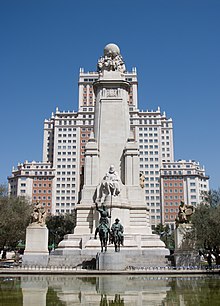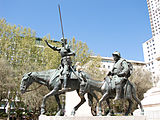Plaza de España, Madrid
- View a machine-translated version of the Spanish article.
- Machine translation, like DeepL or Google Translate, is a useful starting point for translations, but translators must revise errors as necessary and confirm that the translation is accurate, rather than simply copy-pasting machine-translated text into the English Wikipedia.
- Consider adding a topic to this template: there are already 5,022 articles in the main category, and specifying
|topic=will aid in categorization. - Do not translate text that appears unreliable or low-quality. If possible, verify the text with references provided in the foreign-language article.
- You must provide copyright attribution in the edit summary accompanying your translation by providing an interlanguage link to the source of your translation. A model attribution edit summary is
Content in this edit is translated from the existing Spanish Wikipedia article at [[:es:Plaza de España (Madrid)]]; see its history for attribution. - You may also add the template
{{Translated|es|Plaza de España (Madrid)}}to the talk page. - For more guidance, see Wikipedia:Translation.
Plaza de España (Spanish for 'Spain Square') is a large square and popular tourist destination located in central Madrid, Spain at the western end of the Gran Vía. It features a monument to Miguel de Cervantes Saavedra and is adjacent to two of Madrid's most prominent skyscrapers. Additionally, the Palacio Real (Royal Palace) is only a short walk south from the plaza. After 2+1⁄2 years of renovation, on 22 November 2021, the square was reopened for pedestrians.[1]
Cervantes Monument

Right in the center of the square is the monument to Miguel de Cervantes, created at the same time as the square itself. Around the monument, a series of landscaped spaces were created for the enjoyment and rest of passers-by.
In front of the statue of Don Quixote and Sancho Panza, a pond of rectangular form is located that forms one of the best known views of the Spanish capital, along with the Torre de Madrid and Edificio España behind it. Initially, the statues of Don Quixote and Sancho Panza were located, approximately, in what is now the center of the pond, since it was later made. The base of the monument is in granite, with the sculpture made of red stone from Sepúlveda (and some additions in bronze).
Its accomplishment was carried out on the occasion of the third centenary of the publication of the second part of Don Quixote, in 1915, and which continued with the centenary of the death of the writer (1616), in 1916. The author of the project was the architect and sculptor Rafael Martínez Zapatero, who counted on the collaboration of Pedro Muguruza Otaño. The sculptures added were the work of Lorenzo Coullaut Valera.
The figures that make up this emblematic monument have, on the one hand, a seated Cervantes and at the base of the monument, and under the feet of the writer, are the statues of Don Quixote and Sancho Panza. The set was finalized when the figures of Dulcinea and Aldonza Lorenzo were added, also characters of the Cervantes novel. Alluding to the universality of Don Quixote, the monument also contemplates the five continents, all of them reading the work of Cervantes. On the other side and above the fountains, is represented the Spanish Literature, dressed in period and holding a book with his right hand. The tree that predominates in the landscaping of the square is the olive tree, in homage to the La Mancha fields in the wanderings of Don Quixote and Sancho.
-
 Stone sculpture of Miguel de Cervantes
Stone sculpture of Miguel de Cervantes -
 North-eastern side of the Cervantes monument
North-eastern side of the Cervantes monument -
 Bronze sculptures of Don Quixote and Sancho Panza
Bronze sculptures of Don Quixote and Sancho Panza -
 Bronze sculptures of Don Quixote and Sancho Panza
Bronze sculptures of Don Quixote and Sancho Panza -
 Stone sculpture of Aldonza Lorenzo
Stone sculpture of Aldonza Lorenzo -
 Plaza de España, Madrid.
Plaza de España, Madrid.
Surrounding buildings
Adjacent to the plaza are two of the tallest buildings in Madrid, the 142 m (466 ft) Torre de Madrid ("Madrid Tower"), built in 1957, and the 117 m (384 ft) tall Edificio España ("Spain Building"), built in 1953.[2]
There you will also find the House of Gallardo, built in 1911 and considered one of the notable examples of the Art Nouveau style of architecture in the city.
Metro station
Plaza de España is also the name of a Metro station located on the eastern corner of the plaza, serviced by the #3 and #10 lines, with a connection to the #2 line.[3]
History

In 1808, the area was part of the Príncipe Pío hill. It was one of the locations used by French firing squads to execute prisoners taken during the May 2nd uprising.[4]
See also
Notes
References
- Madrid Skyscrapers at skyscraperpage.com
- Estación de Plaza de España / Noviciado from the Spanish-language Wikipedia article. Retrieved May 20, 2006.
- Plaza de España (Madrid) from the Spanish-language Wikipedia article. Retrieved May 20, 2006.

40°25′25″N 3°42′44″W / 40.423485°N 3.712171°W / 40.423485; -3.712171

















